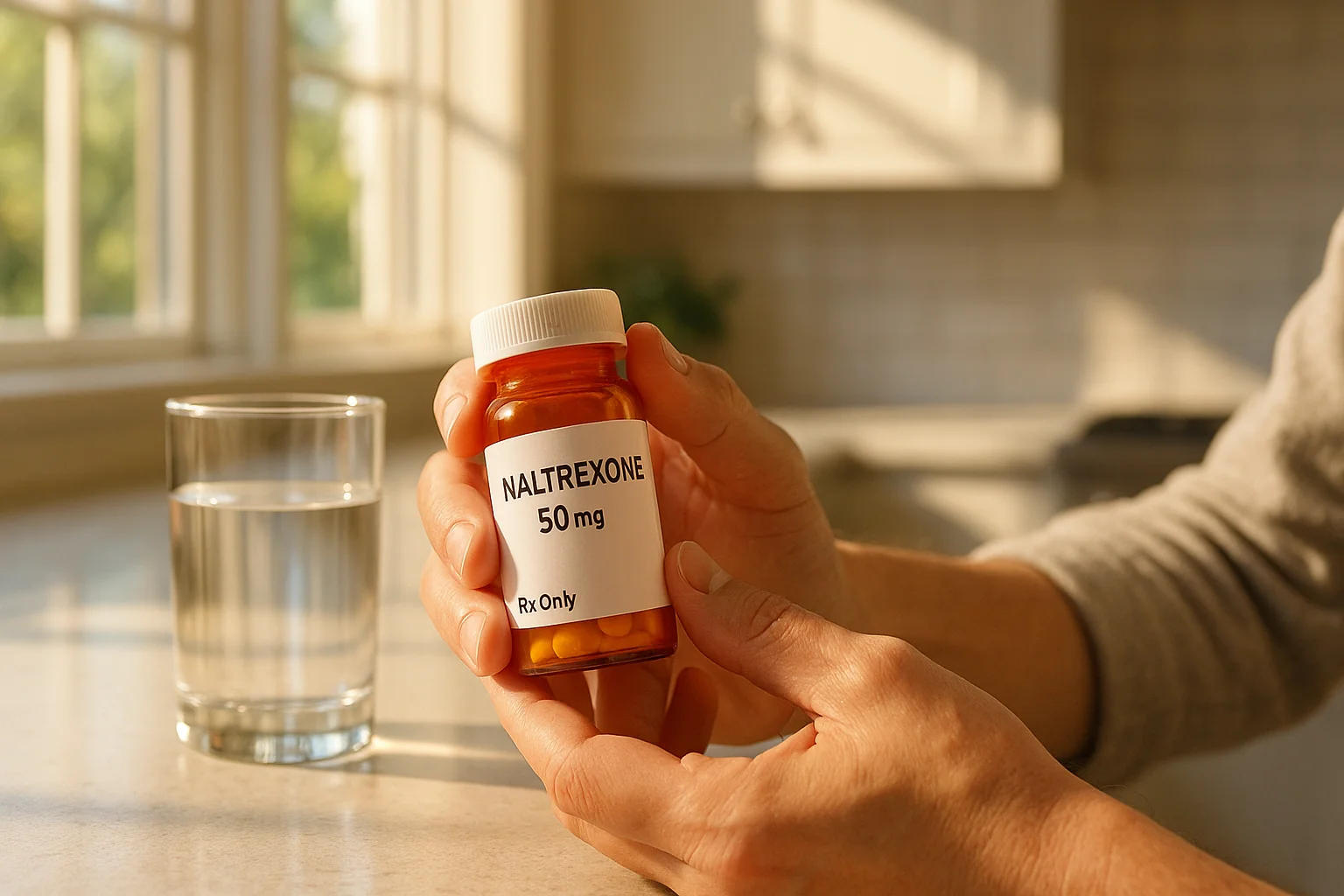A 2 minute assessment to get a personalized mental health or alcohol recovery plan.
Naltrexone 50 mg oral tablets are opioid receptor antagonists approved as part of comprehensive care for alcohol use disorder, helping reduce heavy-drinking days and craving by blocking opioid receptors involved in alcohol's reward signaling, especially when combined with counseling, though they are not a stand-alone cure.
What You'll Discover:
- How naltrexone 50 mg tablets work to reduce alcohol's reward and dampen craving
- Who is a good candidate and essential safety requirements (must be opioid-free)
- Pre-start checklist and standard dosing regimens
- What to expect week by week from side effects to reduced heavy-drinking days
- Critical opioid precautions and liver monitoring guidance
- Evidence from clinical trials showing meaningful reductions in heavy drinking
Naltrexone 50 mg oral tablets (brand name historically Revia; many generics exist) are pure opioid antagonists. For AUD, the 50 mg pill is taken by mouth, commonly once daily, to reduce heavy drinking and help keep urges in check while you work on skills and routines that support change.
Naltrexone does not make you ill if you drink (it's not disulfiram). Its role is to lower alcohol's reward, which can make "just one more" easier to refuse and binge episodes easier to avoid when paired with counseling.
All that said, you must be opioid-free before starting (typically 7 to 10 days for short-acting opioids; longer for others) to avoid precipitated withdrawal. Tell every clinician you're on naltrexone; carry medical ID.
With that in mind, here's exactly how the naltrexone 50 mg pill works, who it helps, and how to use it safely and effectively.
What is the naltrexone 50 mg pill
Naltrexone hydrochloride 50 mg tablets are pure opioid antagonists. For AUD, the 50 mg pill is taken by mouth, commonly once daily, to reduce heavy drinking and help keep urges in check while you work on skills and routines that support change. Naltrexone does not make you ill if you drink (it's not disulfiram). Its role is to lower alcohol's reward, which can make "just one more" easier to refuse and binge episodes easier to avoid when paired with counseling.
How the 50 mg tablet works (in plain English)
Alcohol stimulates endogenous opioid activity, part of the circuitry that tags a behavior as rewarding. Naltrexone competitively blocks those receptors, so the reinforcement from alcohol drops, urges fall, and heavy-drinking days become less frequent. Randomized trials and meta-analyses show meaningful reductions in heavy drinking versus placebo.
Evidence snapshot: A Cochrane review of 50 RCTs (n=7,793) found naltrexone reduced the risk of heavy drinking to 83 percent of placebo (RR 0.83, 95 percent CI 0.76 to 0.90) and decreased drinking days by about 4 percent. A 2023 JAMA review reported lower return-to-heavy-drinking with oral naltrexone 50 mg/day; estimated NNT values are in the modest, clinically useful range.
Who is a good candidate
Consider naltrexone 50 mg tablets if you meet AUD criteria or have recurrent heavy-drinking episodes despite intentions to cut back. Want to reduce or stop drinking and are open to pairing medication with counseling. Are not using opioids and can stay opioid-free.
Not appropriate if you currently use opioid medicines or illicit opioids (including partial agonists like buprenorphine) or are in acute opioid withdrawal. Have a positive opioid screen or fail a naloxone challenge. Have a known hypersensitivity to naltrexone.
Special populations: In pregnancy and breastfeeding, risk-benefit must be individualized (evidence is limited). Discuss with your clinician.
Pre-start checklist (what clinicians do)
Opioid-free interval - Confirm you've been off short-acting opioids for 7 to 10 days (longer for methadone, buprenorphine). A urine opioid screen or a supervised naloxone challenge may be used when there's uncertainty. Starting while opioids are present can cause severe precipitated withdrawal.
Medical review - Liver history, medications (especially any opioid-containing products), and mental-health/medical comorbidities. Baseline liver function tests are common practice.
Informed planning - Education about reduced opioid tolerance after stopping naltrexone, need to carry medical ID, and an emergency plan for unexpected pain (accidents).
Behavioral support - Line up counseling (CBT, motivational interviewing, family-involved approaches). Medication works best when skills and routines change too.
Dosing the 50 mg tablet
Standard regimen - 50 mg once daily with or without food. Some clinicians start lower (25 mg for a few days) to check tolerability, then increase to 50 mg/day. Alternative schedules (100 mg every other day) exist but daily 50 mg is most common in AUD care.
Onset - Many people notice fewer heavy-drinking urges within 1 to 2 weeks, with continued gains over 4 to 8 weeks as counseling skills take hold.
Duration - Typically several months or longer, aligned with your goals and progress. Clinicians reassess benefit, side effects, and labs periodically.
If you miss a dose: Take it when you remember unless it's close to the next dose, then skip and resume your schedule.
What to expect (weeks 1 to 12)
Week 1 to 2 - Possible transient side effects: nausea, headache, dizziness, fatigue, insomnia or vivid dreams. These often fade after the first weeks. Taking with food, hydrating, and earlier dosing can help. Urges may feel blunted; binges can be easier to avoid when paired with specific plans (drink limits, exit scripts).
Week 3 to 6 - Many people report fewer heavy-drinking days and better control in high-risk situations. Sleep and next-day energy often improve as alcohol exposure drops.
Week 7 to 12 - Skills-plus-medication synergy becomes more obvious. Track heavy-drinking days, cravings resisted, sleep, and mood to keep momentum.
If side effects persist or you don't see benefit by about 8 weeks, talk with your clinician about dosing schedule, adherence, and behavioral plan adjustments.
Side effects and precautions (what's common versus important)
Common, usually mild/transient - Nausea, abdominal discomfort, decreased appetite, headache, dizziness, fatigue, insomnia, vivid dreams.
Less common but important to discuss/call about - Liver-related symptoms: right-upper-abdominal pain, dark urine, pale stools, yellowing of eyes/skin, intense fatigue or itching. (Call your clinician; labs may be checked.) Mood changes or unusual agitation, report promptly for assessment.
Hepatic safety in context - The FDA warns of dose-related hepatotoxicity at very high doses; recommended doses (50 mg/day) rarely cause clinically significant injury. Guidance documents suggest baseline and periodic liver tests. Recent cohort analyses indicate naltrexone can be used in liver disease, including compensated cirrhosis, when monitored; evidence in decompensated cirrhosis is more limited, so specialty input is prudent.
Opioids and naltrexone - the rules you must know
Do not start naltrexone until you are opioid-free (confirmed by history and, if needed, a test). Starting too soon can trigger severe precipitated withdrawal. Blockade is surmountable at dangerously high opioid doses. Never attempt to "override" naltrexone; it can cause fatal overdose.
After stopping naltrexone (or after detox), your opioid tolerance is reduced, even a "usual" dose can overdose you. Share this in writing with family/close contacts and all healthcare providers. Consider medical ID noting "on/was on naltrexone - opioid sensitivity/overdose risk."
For unexpected severe pain (accidents), alert clinicians you are taking naltrexone; non-opioid strategies are used first, with specialist protocols if opioids become unavoidable.
Frequently asked questions
Will naltrexone make me sick if I drink? - No. It's not aversive therapy. It works by reducing alcohol's reward and the pull to keep drinking, which helps limit heavy-drinking episodes, especially with counseling.
How effective is the 50 mg pill? - Across randomized trials, naltrexone reduces heavy-drinking risk and modestly reduces drinking days versus placebo. It's not magic, but for many adults it's a meaningful advantage when layered on behavioral care.
How long should I take it? - Often several months or longer, depending on goals and response. Your clinician will revisit benefit, tolerability, and labs at intervals.
Can I take it if I have liver disease? - Discuss with your clinician. At standard dosing, serious liver injury is uncommon; monitoring is standard, and recent data suggest safety in cirrhosis when overseen by specialists, though evidence is thinner in decompensated cases.
What if I need surgery or pain control? - Tell your surgical/anesthesia team well before the procedure. They will plan non-opioid strategies and timing decisions specific to your situation; wearing medical ID helps in emergencies.
Does it affect sleep or weight? - Some people report vivid dreams or insomnia early on; these usually settle. Any weight effects are indirect (via reduced alcohol calories or better routines); the medicine itself isn't a weight-loss drug.
Is there a long-acting shot version? - Yes, an extended-release intramuscular naltrexone exists, but this article focuses on the 50 mg oral pill.
How to get started - safely and effectively
Take a private self-check to understand your pattern and bring results to your visit. Book a clinical visit to confirm candidacy: review of opioid-free status, medical history, baseline liver tests, current meds, and goals. Plan your first 4 to 8 weeks: start 50 mg/day (some start at 25 mg), set clear drinking limits or abstinence goals, and begin/continue counseling. Track heavy-drinking days, urges, sleep, and stress.
Share a safety card with family/close friends noting naltrexone use and opioid sensitivity/overdose risk after discontinuation. Carry medical ID. Reassess at 4 to 8 weeks: fine-tune routines, address side effects, and align the plan with your progress.
The science in context (why it helps real life)
Heavy-drinking days drop because the "why not another?" reward signal is muted, giving your pre-planned limits and exit strategies teeth. Craving is less sticky during high-risk windows (end of workday; post-conflict), making it easier to deploy coping skills instead of defaulting to alcohol. Momentum builds: with fewer binges, sleep continuity improves; better sleep lowers next-day anxiety and urge intensity, creating a positive cycle that therapy consolidates.
When to call your clinician now
New or worsening abdominal pain, yellowing of eyes/skin, dark urine, pale stools, severe fatigue, or intense itching. Any opioid exposure (including cough syrups, pain meds) while on naltrexone or planned procedures where opioids might be used. Persistent side effects that do not ease after two weeks.
Ready to understand whether naltrexone fits your goals?
Curious whether naltrexone 50 mg fits your goals and how much it could reduce heavy-drinking days for you? Our quick, confidential alcohol assessment gives you a private, research-based readout to share with your clinician, plus personalized guidance on safer next steps.
Start your 3-minute alcohol use assessment




